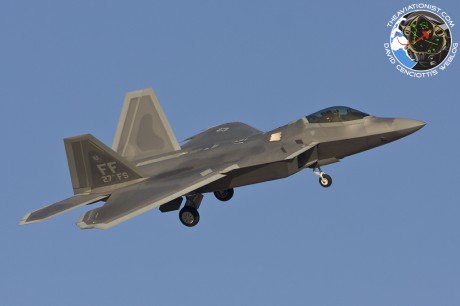
The Flying Test Bed routinely flies with real F-22 Raptors both at Edwards and Nellis Air Force Base, Nevada in order to gain an early look at F-22 mission software.
N757A is a highly modified and instrumented Boeing 757 that has been retrofitted to act as an F-22 flying laboratory. Also referred to as the Flying Test Bed (FTB), the aircraft (the first B757 ever produced), is used to perform flight test of F-22 avionics and sensors in an open-air, operationally representative environment.
The weird 757 Flying Test Bed was used to test the Raptor’s avionics in flight, before the first Raptor ever flew: this was critical to speed up the development of F-22’s avionics – “more highly integrated than anything in existence” – enabling extensive in-flight testing, evaluation and troubleshooting while reducing risk and costs.
The test avionics are operated from a simulated F-22 cockpit installed in the cabin that embeds primary and secondary F-22 displays, as well as a throttle and stick. According to Boeing, the FTB has room on the aircraft for up to 30 software engineers and technicians who can evaluate the avionics, identify anomalies and, in some cases, resolve problems in real-time. Moreover, additional modifications to the 757 include installation of an F-22 radar housed in the forward fuselage section of the quite distinctive nose of the plane, and installation of a sensor wing on the crown of the plane immediately behind the flight deck.
Since the F-22 continues to grow as new software releases make new features, sensors and capabilities available, the FTB, routinely flies with F-22 Raptors both at Edwards AFB, California, and Nellis Air Force Base, Nevada: these joint missions provide the testers an early look at F-22 mission software before the code is released to developmental flight testers, mainly at Edwards.
Although not as much as the F-35, the F-22’s 5th generation capabilities are mostly “software-defined.” For instance, an initial air-to-surface capability, including that of dropping the GBU-39 (a 250-lb multipurpose, insensitive, penetrating, blast-fragmentation warhead for stationary targets equipped with deployable wings for extended standoff range, whose integration testing started in 2007) was introduced on the U.S. premiere air superiority fighter with the software increment 3.1 back in 2012. Then, with the latest upgrades the F-22s have become a real multi-role platformsthat can drop 8 GBU-39 small diameter bombs (while previously limited to carry two 1,000-lb GBU-32 JDAMs – Joint Direct Attack Munitions) in the internal weapon bay, and the AIM-9X Sidewinder, that was first introduced operationally on Mar. 1, 2016 by the 90th Fighter Squadron.

Noteworthy, the FTB visited Edwards earlier in May to examine the F-22 Raptor program’s upgraded mission software, a U.S. Air Force release states.
“This particular FTB deployment provided an excellent training opportunity for the FTB test team, as well as members of the F-22 CTF, while reducing risk to the F-22 3.2B (software) program by allowing us to have an early look at some prototype mission software planned for the final 3.2B software delivery,” said Rachel Kitzmann, Boeing Agile Integration Laboratory F-22 lead test director. “Our F-22 mission equipment is completely segregated from the 757 flight controls, so we can fly with prototype software that has not gone through a formal Equipment Operational Flight Clearance process. This allows us to have an early look at developmental software and problem fixes prior to release to the 411 Flight Test Squadron here at Edwards.”
Interestingly, FTB has the ability to load different software in real-time during flight, allowing multiple configurations to be tested during early developmental testing in pretty long missions, lasting up to seven hours. When not in flight, the FTB is connected to Boeing’s Agile Integration Ground Laboratory, which allows the company to add additional hardware, instrumentation and test equipment required to perform system-level integration and development testing.
“The FTB saves money and reduces the F-22 modernization timeline,” said Kevin Sullivan, 411th FLTS F-22 avionics lead. “It provides risk reduction because it’s easier to fly, fix, fly more quickly instead of having software certified and loaded into an actual F-22. It allows us to look at the avionics software in an F-22 representative hardware and software environment and is capable of acting like an F-22, which can integrate with our F-22s here during test sorties.”

The FTB is based at St. Louis Missouri, since May 5. Previously it operated from Boeing Field in Washington where it had been based since 1999.
Top image credit: Sunil Gupta/Wikimedia
Related articles









